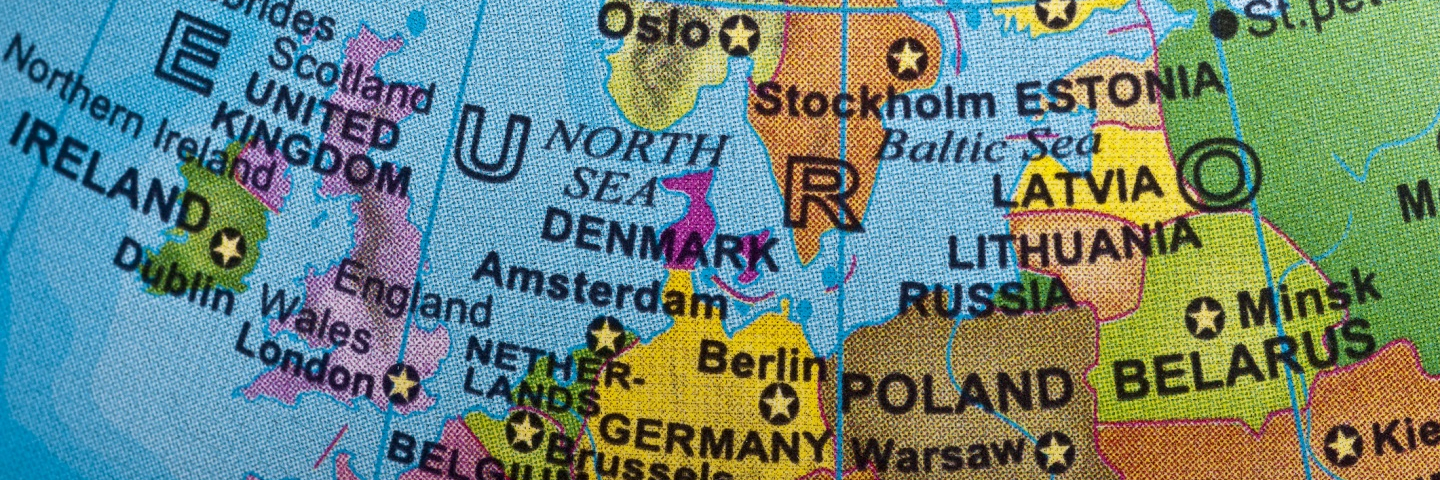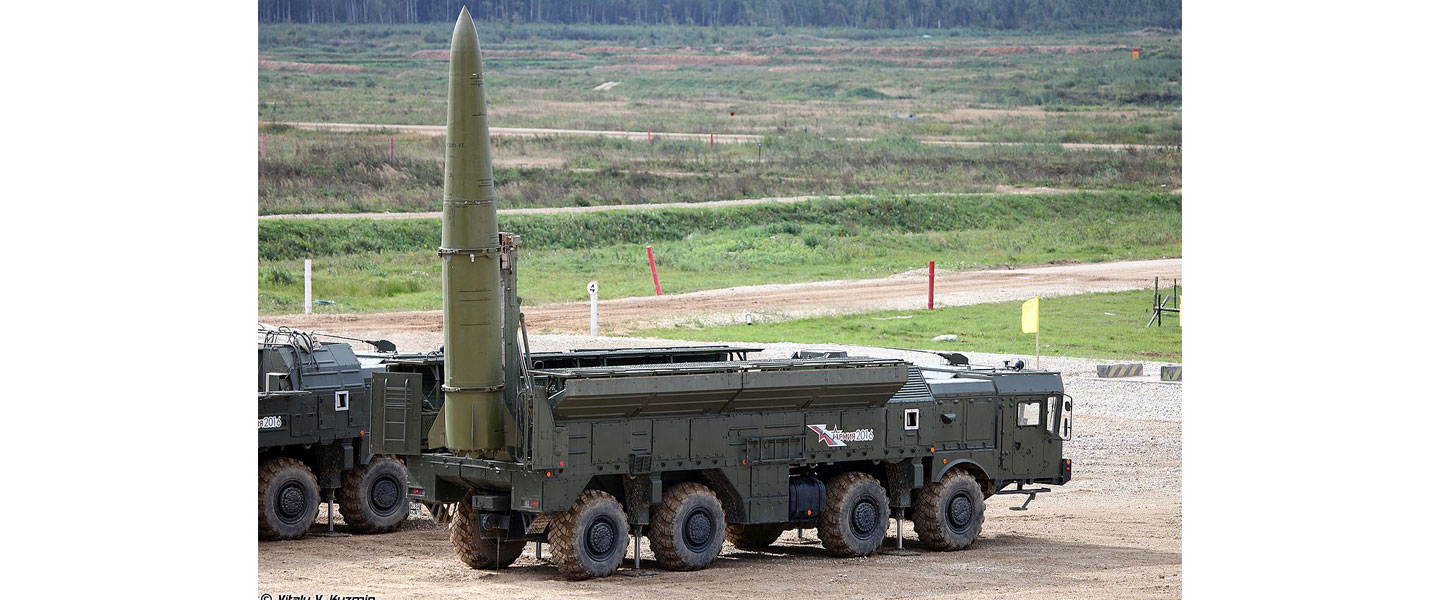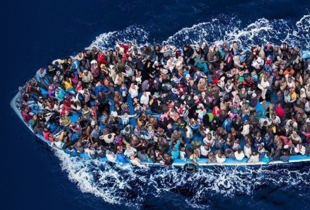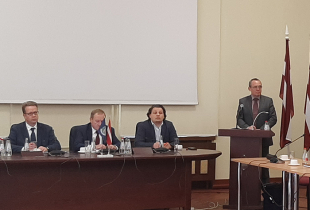
The Baltic States as Targets and Levers: The Role of the Region in Russian Strategy
Executive Summary
- The Baltic states (Estonia, Latvia, and Lithuania) are coming under constant, multi-vector Russian pressure, yet, rather than a prelude to kinetic operations, this pressure is part of Moscow’s wider “political war” with the West.
- The Baltic states are considered targets not because the Russians believe that these states can be returned to Russia’s sphere of influence—indeed, Russians lost that belief long ago. Rather, Russia uses the Baltic states to exert leverage against a variety of other actors, including the United States, the North Atlantic Treaty Organization (NATO), the European Union (EU), the neutral Nordic states (e.g., Sweden), and even Belarus.
- Russia considers the independence of the Baltic states and their active role in NATO and the EU as threats to Russia’s security, sovereignty, and autonomy. The Vladimir Putin regime’s operational code inclines it to respond with multiple, varied, and often independent covert political means.
That the Baltic states are under constant Russian pressure is undeniable, from official denunciations to unofficial disinformation and from overt shows of military strength to covert intelligence operations. On the other hand, it is less clear what Moscow’s limits and goals are. Lithuanian president Dalia Grybauskaitė may warn that “the likelihood [of Russian invasion] is high if we don't constantly defend ourselves,” but there is no serious evidence of Russian territorial ambitions in the region.1
Before the worsening of Russia-Western relations in 2014, the Russian speakers of Narva, Estonia, and Riga, Latvia, in particular, were willing to leverage their sense of being excluded and neglected in the name of mobilizing constituencies for political impact. However, they show no enthusiasm now for exchanging membership of prosperous, democratic European states for Kremlin rule. Furthermore, Moscow appears to understand how unwelcome and dangerous direct intervention would be, over and above bringing Russia into direct conflict with NATO. As one recently retired Russian general staff officer noted, when asked about the state of contingency planning for such operations, “the trouble with the Baltic States is that they are full of Balts,” in other words, in his eyes, a feisty, contrary people who have already shown the will and capacity to resist under overwhelming odds.2
Traditionally, the debate about Russia’s objectives in the region has been about whether it seeks outright territorial expansion or merely political influence. Neither is the true aim; instead Russia seeks leverage outside the region rather than within and considers the Baltic states a theater in every sense, in which offensive intent can be signaled and offensive capabilities demonstrated without leading to open conflict.
Strategic Culture and Operational Code
The extent to which the Kremlin’s perspective on the Baltic States is shaped by Russia’s distinctive strategic culture and the current regime’s operational code are clear. To put it at its simplest, Russian strategic culture—that is, its broad understanding of what poses a threat and under what circumstances it should turn to coercion and war—ensures that it considers the Baltic states, for all their small size and essentially defensive posture, as a challenge, as well as an opportunity. The regime’s operational culture—that is, its habitual assumptions about how policy is best made and executed—dictates a response anchored around a mix of overt pressure and covert subversion. Together, they generate five specific elements of the Kremlin’s current perspective:
- Russia must use offensive actions to defend itself: There is an underlying assumption that Russia is perennially under threat. NATO is not accepted on its own terms as genuinely defensive, and simply by constraining Moscow’s strategic options, the Baltic states’ strong and understandable commitment to NATO becomes a challenge to Russian security and freedom of maneuver. Aggressive Russian policy is thus considered a proactive response to a foreign threat.
- The Baltic states have historically modified sovereignty: Moscow may not consider the Baltic states part of Russia’s “regions of privileged interest” (Dmitry Medvedev’s term).3 Nevertheless, because the Baltic states have Russophone populations and were formerly part of Moscow’s empire, Russians consider them to have what can be described as limited or modified sovereignty that ought to be constrained, at least to an extent, by Russia’s interests. The 2015 decision by the Prosecutor General’s Office to review the legality of the 1991 decision to grant the Baltic states independence was symbolic, for example, but spoke to a broader conviction in Russian official circles that the Balts owe them something.
- A strong defense simply shifts the battlefield: NATO membership and the likelihood of a bitter guerrilla struggle against any military adventure may mean that direct kinetic measures against the Baltic States are off the board, but it does not, in any way, end the game. Rather, the operational code of Russia’s regime indicates simply a shift to a wholly political campaign to secure the same goals.4
- Democracies are best tackled politically: Indeed, it is clear that Putin, heir of his own KGB training and witness to Russian fragmentation in the 1990s and Western legitimacy crises today, considers such political warfare as a preferable and profitable policy option when tackling democratic states and alliances.
- Everything connects to everything else: Vladimir Lenin’s apocryphal dictum is strongly visible in Russia’s current tendency to view almost every policy issue, from Syria and Cuba to Nordstream 2 and the Donbass, in terms of its relevance to the primary aim of influencing or marginalizing the United States. Perversely, the Baltic states have leverage value because of their effectiveness in mobilizing their historic experience and current vulnerability to the EU, NATO, and Washington.
Targets
Moscow’s targets in the region, beyond the Baltic states, are second-order, more about leverage outside the region than any great expectations within it. Those targets include :
- The EU: Pressure on the Baltic states contributes to a fissiparous tendency within the EU, alarming some, who then advocate reaching an agreement with Russia to reduce tensions, even while alienating others, who feel that the real and present danger comes from the south, not the east.
- NATO: Similarly, because NATO is committed to the defense of the Baltic states, it increases the costs for countries that see a more immediate threat from North Africa and the Middle East, generating tensions among NATO members. NATO has more recently required the Allies to devote resources to defending the Baltics (notably, the Enhanced Forward Presence and Baltic Air Policing strategies).
- The United States: U.S. President Donald Trump has reportedly suggested that Crimea is Russian territory because it is Russian-speaking,5 and he has muddled the Balkans and the Baltics.6 As a result, old assumptions about the security and indivisibility of the Baltic states seem to be under question. Overall, as the United States is considered potentially semi-detached from NATO, Moscow is also exploring how pressure specifically on the Baltic states can influence its relationship with Washington.7
- The Nordic states: The nations of northern Europe are understandably concerned about the potential threat from Russia; some share borders with Russia and face genuine offensive capabilities. Again, to some, this is a reason for increased armament and defensive cooperation, but, to others, it is grounds to reach some kind of accord with Moscow.
Beyond this, though, there are also real—if misguided—defensive concerns, as well as human idiosyncrasies, at work. Moscow persists in its belief that it could face some kind of threat from its northwestern flank, not so much from NATO but from some “coalition of the hostile,” including Poland and the Baltic states, which would first launch subversive “hybrid” political operations, as wargamed in the Zapad 2017 exercises. However fanciful this may strike Westerners, it is genuinely regarded as a plausible scenario by many within the Russian national security establishment. More generally, there is considerable animus toward Estonia in particular—notably, by all accounts, from Vladimir Putin himself. As a result, pressure on the Baltic states is also viewed as both a deterrent against any aggressive intent and retribution for perceived “Russophobia.”

Modes of Engagement
As with all expressions of Russia’s present campaign of political war,8 the modes of engagement are opportunistic and multi-vector. Sometimes, moves are generated by initiatives from specific local actors, such as embassies and business magnates, and sometimes they are managed from Moscow.9 The following five specific aspects are of particular importance, three of which are aspects of coercive “heavy metal diplomacy”10 involving the use of the military and two of which are rather broader:
- Deployments of military forces represent not simply Russian responses to perceived vulnerabilities but also demonstrative political acts. For example, the 2016 deployment of Iskander-M (SS-26) missiles into Kaliningrad—weapons that can mount nuclear warheads—was clearly a move calculated for its symbolic as much as practical impact.
- Russia’s anti-access/area denial (A2AD) capabilities undoubtedly would have a major military role in any future conflict, but they already have a powerful political effect. By raising the specter—justified or not11—that a conflict in the Baltics could be “bubbled” and prevented from becoming a wider one, these capabilities bring the NATO guarantee into question and reduce local confidence that a Russian force can be contained.
- Exercises are also conducted not simply for direct military utility but also with an eye to their effects on the West. Thus, they are not just military but also media productions and diplomatic initiatives. The best example is the aforementioned quadrennial Zapad (“West”) exercises, which at various times have simulated a nuclear strike on Poland (2009), showcased new drone capabilities (2014), and hinted at a war on the Nordic flank (2017).
- Information operations—which have an especially capacious meaning for the Russians, including everything from espionage and hacking to soft power and propaganda—also extend to a sustained effort to use disinformation to create divisions within the Baltics themselves and between the Baltics and their NATO and EU allies. This has been especially evident in Russian efforts to turn the presence of NATO forces into a political liability, such as through false claims of rapes of local women by German soldiers in Lithuania and abuses by Canadians in Latvia.12
- Political measures beyond the above include direct political subversion, intelligence operations, bilateral diplomatic relations, and the rest of the panoply of means of geopolitical influence, beyond the scope of this brief. In particular, Moscow seeks to influence and work through real and fake civil society front organizations and parties, such as Latvia’s Association for the Development of Russian Civil Society and Support of Russian Emigrants, Estonia’s Center Party, and the Electoral Action of Poles in Lithuania.
Decision-Making
The structure of Russian policy-making over the Baltic states is thus equally diffuse, even if necessarily anchored to a strategic vision provided by the Kremlin and the need to secure leadership buy-in for more than trivial and tactical initiatives. It is worth breaking that structure of policy-making down into two levels:
- Strategic and operational: Clearly all major decisions need to be approved by President Putin, who has also set forth the broad strategic vision of a “great-power” Russia with a sphere of influence (not necessarily including the Baltic states), a global voice, and immunity from international laws and norms. Beyond this, though, the management of Russia’s relations with the Baltics, and its political warfare in particular, appears vested in neither the Ministry of Foreign Affairs nor the Ministry of Defense but instead in the Presidential Administration (AP). This reflects both (1) a strategic culture that sees national security as the crucial responsibility of the head of state and (2) an operational code that de-emphasizes the autonomy of ministries and stresses instead the coordinating role of the AP.
- Tactical: In contrast with the centralized, AP-dominated model visible at the strategic and operational levels, the majority of specific policy-making activities are generated and conducted by actors operating often under the loosest supervision and with little evidence of coordination. Command and control is replaced by a largely unspoken set of understandings about the broad strategic aims and the limits of local initiative. Thus, the majority of intelligence, disinformation, and similar activities neither need nor receive direct sanction from the Kremlin. If successful, they may be adopted and become the core of more-comprehensive operations; if unsuccessful, they can be ignored or disavowed. Obviously, major and overt activities, such as military exercises, are part of coordinated policy, and actions with potential serious international implications, such as the kidnapping of Estonian security officer Eston Kohver in 2014 and the likely jamming of Latvian mobile communications in 2017, are initiated or approved by the Kremlin.
Constraints and Enablers
The combination of (1) a strategic culture that gives primacy to addressing threats not just to Russia’s territorial integrity but also its geopolitical autonomy and (2) an operational code predicated on a diffuse, opportunistic, and aggressive political struggle devolved to multiple actors and instruments would seem to give the Kremlin considerable advantages. Unencumbered by democratic oversight and legal accountability and able to mobilize a wide range of separate and often deniable (political) warfighters, the Russians undoubtedly have the initiative.
However, the initiative is not always the same as the advantage. The value of “implausible deniability” and covert subversion appears to be diminishing. A suspicious, even paranoid, strategic culture locks an impoverished Russia into a zero-sum strategic competition with a richer, stronger, more dynamic West. Even in the Baltic region, short-term leverage is typically acquired only at the cost of long-term cost. Estonia is making renewed efforts to engage and incorporate its Russophone population lest they become a security risk. NATO is more active in the region than ever. Sweden and Finland may not be joining the Alliance but are increasingly cooperating with it while also reviving their defense spending. Meanwhile, Moscow is committed to expensive modernization of its military structures in the northwestern quadrant, and hopes that Kaliningrad could become a “Russian Hong Kong” have been sacrificed to make it an A2AD bastion (of dubious strategic advantage).
Much the same is true of the impact of Putin’s operational code. Encouraging an entrepreneurial and decentralized political campaign buys diversification and tempo of operations at the cost of control and clear cost-benefit analysis. It is questionable how truly effective most of these efforts have been, even as they have stimulated an increase in counter-intelligence and counter-disinformation work through the Baltic region. In the words of one Nordic intelligence official, “through lots of trivial attacks, Moscow has only managed to give the Baltic security agencies experience, determination, and budgets.”13 Moscow’s strategic culture and operational code are therefore, at once, advantages and curses.
For Academic Citation
Mark Galeotti, “The Baltic States as Targets and Levers: The Role of the Region in Russian Strategy,” Marshall Center Security Insight, no. 27, April 2019, https://www.marshallcenter.org/en/publications/security-insights/baltic-states-targets-and-levers-role-region-russian-strategy-0.
Notes
1 Annette Langer, “Die junge Generation ist bereit, unser Land zu verteidigen [The Young Generation is Prepared to Defend Our Country],” Der Spiegel, June 19, 2018, http://www.spiegel.de/politik/ausland/litauen-praesidentin-dalia-grybauskaite-im-interview-a-1212292.html.
2 Russian general staff officer, conversation with the author, Moscow, 2017.
3 "Interview Given by Dmitry Medvedev to Television Channels Channel One, Rossia, NTV,” Kremlin, August 31, 2008, http://en.kremlin.ru/events/president/transcripts/48301.
4 For more on this dual-track Russian understanding of modern conflict, see Mark Galeotti, “I’m Sorry for Creating the ‘Gerasimov Doctrine,’” Foreign Policy, March 5, 2018, https://foreignpolicy.com/2018/03/05/im-sorry-for-creating-the-gerasimov-doctrine.
5 Alberto Nardelli and Julia Ioffe, “Trump Told G7 Leaders That Crimea Is Russian Because Everyone Speaks Russian in Crimea,” Buzzfeed, June 14, 2018, https://www.buzzfeednews.com/article/albertonardelli/trump-russia-crimea.
6 Martin Pengelly and Lois Beckett, “Trump Cancels U.S .Cemetery Visit amid Diplomatic Embarrassment,” Guardian, November 10, 2018, https://www.theguardian.com/us-news/2018/nov/10/trump-baltics-balkans-mixup-le-monde-belleau-cemetery-paris.
7 That Moscow is revisiting how pressure on the Baltic states can be used specifically to influence Donald Trump’s United States was confirmed to me in multiple conversations in Moscow, 2018.
8 George Kennan’s prescient term fits better than more-debatable terms, such as “hybrid war” or “new-generation warfare” (the favored Russian term), which still carry with them an implication that the political phases of any operation are never more than the prelude to the use of military force.
9 For more on the varied sources of Russian initiatives, see Mark Galeotti, Controlling Chaos: How Russia Manages Its Political War in Europe, London: European Council on Foreign Relations, September 1, 2017, http://www.ecfr.eu/publications/summary/controlling_chaos_how_russia_manages_its_political_war_in_europe.
10 I develop this term and concept in Mark Galeotti, Heavy Metal Diplomacy: Russia’s Political Use of Its Military in Europe Since 2014, London: European Council on Foreign Relations, December 19, 2016, https://www.ecfr.eu/publications/summary/heavy_metal_diplomacy_russias_political_use_of_its_military_in_europe_since; and Mark Galeotti, Russian Political War: Moving Beyond the Hybrid, (London: Routledge, 2019).
11 As U.S. Chief of Naval Operations Adm. John Richardson has noted, “the term ‘denial,’ as in ‘anti-access/area denial’ is too often taken as a fait accompli, when it is, more accurately, an aspiration. . . . But the reality is much more complex” in John Richardson, “Chief of Naval Operations Adm. John Richardson: Deconstructing A2AD,” The National Interest, October 3, 2016, http://nationalinterest.org/feature/chief-naval-operations-adm-john-richardson-deconstructing-17918.
12 See “Lithuania Looking for Source of False Accusation of Rape by German Troops,” Reuters, February 17, 2018, https://www.reuters.com/article/us-lithuania-nato/lithuania-looking-for-source-of-false-accusation-of-rape-by-german-troops-idUSKBN15W1JO and Tom Blackwell, “Russian Fake-News Campaign Against Canadian Troops in Latvia Includes Propaganda About Litter, Luxury Apartments,” National Post, November 17, 2017, http://nationalpost.com/news/canada/russian-fake-news-campaign-against-canadian-troops-in-latvia-includes-propaganda-about-litter-luxury-apartments.
13 Nordic intelligence official, conversation with the author, June 2018.
About the Author
Dr. Mark Galeotti is an Honorary Professor at the UCL School of Slavonic and East European Studies and a Senior Associate Fellow at the Royal United Services Institute, as well as a Senior Non-Resident Fellow at the Institute of International Relations Prague and previously head of its Centre for European Security. Now based in London, for the academic year 2018-19 he is a Jean Monnet Fellow at the European University Institute. He is an expert and prolific author on transnational crime and Russian security affairs.
Russia Strategic Initiative (RSI)
This program of research, led by the GCMC and funded by RSI (U.S. Department of Defense effort to enhance understanding of the Russian way of war in order to inform strategy and planning), employs in-depth case studies to better understand Russian strategic behavior in order to mitigate miscalculation in relations.
The Marshall Center Security Insights
The George C. Marshall European Center for Security Studies in Garmisch-Partenkirchen, Germany, a German-American partnership, is committed to creating and enhancing worldwide networks to address global and regional security challenges. The Marshall Center offers fifteen resident programs designed to promote peaceful, whole of government approaches to address today’s most pressing security challenges. Since its creation in 1992, the Marshall Center’s alumni network has grown to include over 13,985 professionals from 157 countries. More information on the Marshall Center can be found online at www.marshallcenter.org.
The articles in the Security Insights series reflect the views of the authors and are not necessarily the official policy of the United States, Germany, or any other governments.

